SEL 2022
Du 12/09/2022 au 23/09/2022
La Vieille Perrotine - CAES du CNRS - 140 Route des Allards, 17310 Saint Pierre d'Oléron
 |
Robert PREVEDEL European Molecular Biology Laboratory (EMBL), Heidelberg, Germany Robert Prevedel is a group leader at the European Molecular Biology Laboratory, Heidelberg (Germany). His primary research interest lies in developing advanced and innovative optical techniques for biomedical imaging, such as multi-photon and light field-microscopy, photo-acoustics or Brillouin spectroscopy. Robert holds a PhD in experimental physics from the University of Vienna (Austria) and performed postdoctoral research at the University of Waterloo (Canada) and at the Institute of Molecular Pathology in Vienna (Austria). Brillouin microscopy: an emerging tool for mechanobiology Keywords: Brillouin microscopy, biomechanics, bio-imaging Summary: Mechanical properties of cells and tissues have been shown to play a crucial role in development and disease, but standard techniques for probing them are usually invasive and limited to the sample’s surface. In contrast, Brillouin microscopy [1–3] is an emerging optical technique that enables non-contact measurement of viscoelastic properties of a material with diffraction-limited resolution in 3D. In my lecture, I will briefly introduce and review this emerging field before discussing our current efforts to study the role of mechanical properties in developing organisms such as zebrafish and drosophila embryos, as well as in the early detection of disease. References: 1. G. Scarcelli and S. H. Yun, "Confocal Brillouin microscopy for three-dimensional mechanical imaging," Nat Phot. 2, 39–43 (2008). 2. R. Prevedel, A. Diz-Muñoz, G. Ruocco, and G. Antonacci, "Brillouin microscopy: an emerging tool for mechanobiology," Nat. Methods 16, 969–977 (2019). 3. G. Antonacci, T. Beck, A. Bilenca, J. Czarske, K. Elsayad, J. Guck, K. Kim, B. Krug, F. Palombo, R. Prevedel, and G. Scarcelli, "Recent progress and current opinions in Brillouin microscopy for life science applications," Biophys. Rev. 12, 615–624 (2020). |
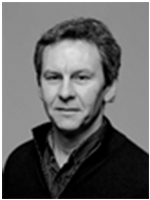 |
Hervé RIGNEAULT Institut Fresnel Aix Marseille Univ - CNRS - Ecole Centrale Marseille Hervé Rigneault is a CNRS research director in the Mosaic group that he leads at the Fresnel Institute (Marseille France) (https://www.fresnel.fr/spip/spip.php?article1102). He is the author and co-author of 260 publications in the field of optics and biophotonics. His current field of research encompass molecular spectroscopy and imaging using coherent microscopy and endoscopy. Coherent Raman imaging: from principle to applications Keywords: Raman, coherent Raman, stimulated Raman, Microscopy, endoscopy Summary: The first part of the lecture will present the basics of coherent Raman light matter interaction for molecular spectroscopy and imaging. The second part will be devoted to coherent Raman technology in microscopy and endoscopy whereas the last part of the lecture will address the applications in the fields of chemical imaging, biological and medical sciences. References: H. Rigneault, and P. Berto, "Tutorial: Coherent Raman light matter interaction processes," APL Photonics 3, 091101 (2018). https://doi.org/10.1063/1.5030335 X. Audier, S. Heuke, P. Volz, I. Rimke, and H. Rigneault, "Noise in stimulated Raman scattering measurement: From basics to practice," APL Photonics 5, 011101 (2020). https://doi.org/10.1063/1.5129212 R. A. Bartels, D. Oron, and H. Rigneault, "Low frequency coherent Raman spectroscopy," Journal of Physics: Photonics 3, 042004 (2021). https://doi.org/10.1088/2515-7647/ac1cd7 J. X. Cheng, W. Min, Y. Ozeki, and D. Polli, Stimulated Raman Scattering Microscopy: Techniques and Applications (Elsevier Science, 2021). |
 |
Pascal RUELLO Professor at Le Mans University and researcher at the Institute of Molecules Materials UMR CNRS 6283, Le Mans University, France Pascal Ruello, Professor of Physics, is specialist in solid states physics and ultrafast phenomena in condensed matter (time-resolved spectroscopies of electrons and phonons). He contributed to the description and the evaluation of the physical mechanisms of ultrafast photogeneration of coherent acoustic phonons in solids, including semiconductors and ferroic materials for instance. He also contributed to the development of nanoscale imaging of transparent materials with time-resolved Brillouin light scattering spectroscopy. Ultrafast phonon generation and detection in solids : a combination of optical, THz and X-ray light pulses Keywords: Time-resolved spectroscopy, picosecond acoustics, light-induced strain phenomena Summary: Phonon time-resolved spectroscopies born in the eighties have opened the route for the control of lattice dynamics in bulk materials and nanostructures including acoustic (GHz-THz) [1-4] and optical (Thz) [5] phonons. Among these time-resolved spectroscopies, picosecond acoustics has revealed important advantage for understanding the light-induced strain in solids [1-4], for the development of non-destructive testing of nanostructures and for submicrometer scale imaging in transparent materials [6] based on the time-resolved Brillouin scattering [7]. In picosecond acoustics, many experiments have been conducted with optical pump-probe scheme where the photon energy (pump and/or probe) is in the NIR-VIS-NUV range usually. With the advent of new time-resolved spectroscopies such as time-resolved X-ray diffraction [8] and THz spectroscopy [9] it appears now possible to envision new way to drive the motion in the matter and to probe the absolute ultrafast light-induced strain. In this lecture, after a general presentation of picosecond acoustics (generation/detection), I will present recent achievements where a combination of different light sources (visible, THz, RX) offers new opportunities to understand the physics of ultrafast phonon generation and detection in different materials such as metals [10], multiferroics [11] and phase change materials [12] for instance. References: [1] C. Thomsen et al, Phys. Rev. B 34 (1986) 4129 [2] B. Perrin et al, Prog. Nat. Sci. 6 444 (1996) [3] V. Gusev, A. Karabutov, Laser Optoacoustics, AIP, New York, 1993 [4] P. Ruello, V. E. Gusev, Ultrasonics 56, 21-35 (2015) [5] R. Merlin, Sol. State. Comm. 102, 207–220 (1997) [6] V.E. Gusev, P Ruello, Appl. Phys. Rev. 5 (3), 031101 (2018) [7] C. Thomsen et al, Opt. Comm. 60, 55-58 (1986) [8] A. Lindenberg et al, Phys. Rev. Lett. 84, 111 (2001) [9] T. Kampfrath et al, Nat. Photon., 7, 680–690 (2013) [10] A. Levchuk et al Phys. Rev. B 101 (18), 180102 (2020) [11] V. Juvé et al, Phys. Rev. B 102, 220303(R) (2020) [12] R. Gu et al, Phys. Rev. Appl. 16 (1), 014055 (2021) |
 |
Philip RUSSELL MPL Erlangen (Emeritus director) & RCALS Hangzhou (Director) Professor Philip Russell is an emeritus founding Director of the Max-Planck Institute for the Science of Light (MPL) in Erlangen, Germany and since 2022 has been Director of the RCALS Centre for Advanced Lightwave Science in Hangzhou, China. He is a Fellow of the Royal Society and Optica (formerly The Optical Society, OSA) and has received a number of awards recognising his work on photonic crystal fi-bres and their numerous scientific and commercial applications, including in optoacoustics and optome-chanics. He was OSA's president in 2015, the International Year of Light. Optomechanical Phenomena in Photonic Crystal Fibres Summary: Photonic crystal fibre (PCF) technology makes it possible to produce long lengths of very small (scale of 1 µm) glass cores surrounded by hollow channels. Such cores support tightly confined few-GHz acoustic resonances and offer close-to-100% optoacoustic overlap, providing a unique system for achieving stable passive high harmonic mode-locking of fibre lasers [1] [2]. Light can be guided in hollow core PCF over long distances in a well-controlled single mode, allowing the trapping and laser propulsion of small parti-cles to be studied. Among recent experiments include optical binding of particles at cm-scale distanc-es [3], continuous monitoring of PM2.5 particles in the atmosphere [4], precession and nutation of bire-fringent particles driven by circularly polarized light in chiral PCF [5], ablation-driven rocket-like propul-sion of particles by single fs pulses [6] and optomechanically stabilized launching of light into hollow core PCF using a mechanically compliant glass nanospike [7] [8]. References: 1. W. He, M. Pang, D.-H. Yeh, J. Huang, C. R. Menyuk, and P. St. J. Russell, "Supramolecular transmission of soliton-encoded bit streams over astronomical distances," Nat. Comm. 10, 5756 (2019). 2. D.-H. Yeh, W. He, M. Pang, X. Jiang, G. K. L. Wong, and P. St. J. Russell, "Pulse-repetition-rate tuning of a harmonically mode-locked fiber laser using a tapered photonic crystal fiber," Opt. Lett. 44, 1580–1583 (2019). 3. A. Sharma, S. Xie, and P. St. J. Russell, "Reconfigurable millimeter-range optical binding of dielectric microparticles in hollow-core photonic crystal fiber," Opt. Lett. 46, 3909 (2021). 4. A. Sharma, S. Xie, R. Zeltner, and P. St. J. Russell, "On-the-fly particle metrology in hollow-core photonic crystal fibre," Opt. Exp. 27, 34496–34504 (2019). 5. S. Xie, A. Sharma, M. Romodina, N. Y. Joly, and P. St. J. Russell, "Tumbling and anomalous alignment of optically levitated anisotropic microparticles in chiral hollow-core photonic crystal fiber," Sci. Adv. 7, eabf6053 (2021). 6. M. N. Romodina, S. Xie, A. Sharma, F. Tani, and P. St. J. Russell, "Femtosecond laser micromachining and rocket propulsion of micro-particles optically trapped in hollow-core photonic crystal fibre," in CLEO/Europe and EQEC 2021 Conference Digest (2021), p. paper CM-5.1 THU. 7. S. Xie, R. Pennetta, and P. St. J. Russell, "Self-alignment of glass fiber nanospike by optomechanical back-action in hollow-core photonic crystal fiber," Optica 3, 277–282 (2016). 8. S. Xie, R. Pennetta, Z. Wang, and P. St. J. Russell, "Sustained self-starting orbital motion of a glass-fiber “nanoengine” driven by photophoretic forces," ACS Photonics 12, 3315–3320 (2019). |
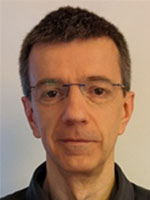 |
Lucien SAVIOT Laboratoire Interdisciplinaire Carnot de Bourgogne UMR 6303 CNRS-Université Bourgogne Franche-Comté 9 Avenue Alain Savary, BP 47 870, 21078 Dijon Cedex Dr. Lucien Saviot is a CNRS senior researcher at Université de Bourgogne in Dijon. His main research activity is devoted to the vibrational spectroscopy of nanomaterials. He is interested in particular in inelastic light scattering by acoustic vibrations of nano-objects having various composition (semiconductor, metal, metal oxide), shape (sphere, rod, platelet, cube) and crystallinity (isotropic, cubic, ...). Acoustic vibrations of nano-objects Keywords: nanoparticles, Raman scattering, acoustic vibrations, crystallinity, symmetry Summary: Acoustic vibrations of nanoparticles were first observed using inelastic light scattering 4 decades ago. Significant advances in the synthesis of nano-objects and frequency and time-domain spectroscopy techniques have made it possible to investigate the sensitivity of these vibrations to the structure (size, shape, crystal structure) and environment of the nano-objects. This lecture will present an overview of this field and focus in particular on recent experimental results and models required to describe the acoustic vibrations of various kinds of nano-objects and their symmetry. References: - E. Duval, A. Boukenter, and B. Champagnon, Phys. Rev. Lett. 56, 2052 (1986) - H. Portalès, N. Goubet, S. Casale, X. Z. Xu, M. Ariane, A. Mermet, J. Margueritat, and L. Saviot, ACS Nano 14, 4395 (2020) - https://saviot.cnrs.fr |
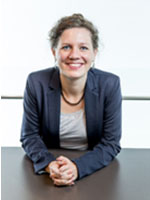 |
Birgit STILLER Max-Planck-Institute for the Science of Light, Erlangen, Germany Birgit Stiller is an experimental physicist and the leader of an independent Max Planck Research Group at the Max Planck Institute for the Science of Light (MPL) in Erlangen, Germany. Her group’s interest is on Brillouin scattering and optoacoustic interactions in waveguides and optical fibers at the classical and quantum level. Her wider research background is in nonlinear optics, quantum communications and integrated optics. Before she held a position as Postdoctoral Research Fellow at the University of Sydney, Australia, and was a Postdoctoral Researcher in the field of quantum cryptography in Erlangen. She received her PhD from the CNRS Institute FEMTO-ST Besançon, France. Storing light into sound waves and Brillouin-based signal processing Keywords: Stimulated Brillouin scattering, optoacoustic light storage, nonlinear optical signal processing, photonic circuits, photonic crystal fibers Summary: Optical and traveling acoustic waves can interact over the coherent process of stimulated Brillouin scattering (SBS), which is a third-order nonlinear optical effect. SBS has been of crucial importance for applications in optical fiber sensing, microwave photonics, Brillouin lasers and signal processing. The latter includes calculus operations and signal amplification but also light storage of signal streams [1,2]. By using traveling acoustic waves, we recently showed proof-of-principle experiments of Brillouin-based light storage [2–7], such as the tunable delay and coherent retrieval of an optical signal [2], as well as cascaded storage at different spatial positions [3]. A particularity of Brillouin-based light storage is the strict phase-matching condition. This allows for different features: nonreciprocal storage over a large bandwidth [4] and simultaneous storage at multiple wavelengths with negligible crosstalk [5], which distinguishes the waveguide approach from optomechanical resonators. The delay time of this technique has so far been limited to the acoustic lifetime of about 10 ns. In recent results though, we were able to experimentally demonstrate how to reinforce acoustic phonons to overcome the obstacle of the limited acoustic lifetime. We showed for the first time the storage of amplitude and phase of an optical signal via stimulated Brillouin scattering up to 40 ns, which can potentially be further expanded [6]. Another interesting topic is the optoacoustic interaction of short pulses whose bandwidth is well beyond the Brillouin linewidth [7]. We have experimentally demonstrated the SBS interaction of optical pulses down to 150 ps and achieved a time-delay in Brillouin-based memory of 100 pulse-widths [8]. In this talk, I will give an overview about light storage and optoacoustic signal processing [9], speak about the challenges and chances of waveguide optoacoustics via SBS [10-12] and present recent achievements in more exotic types of waveguides: liquid-filled capillary fibers and twisted photonic crystal fibers [12]. References: [1] Zhu et al, Science 318, 1748 (2007) [2] Merklein et al., Nature Comm. 8 (2017) [3] Stiller et al., Optics Letters 43 (18) (2018) [4] Merklein et al., Nanophotonics 10(1) (2020) [5] Stiller et al., APL Photonics 4 (2019) [6] Stiller et al., Optica, 5 (7) (2020) [7] Piotrowski et al., Optics Letters 46, 2972 (2021) [8] Jaksch et al., in Frontiers in Optics 2017, PDP paper FTh4A.5 [9] Merklein et al., Review, Journal of Optics (2018) [10] Wolff et al., Invited Tutorial, Josa B 38 (4) (2021) [11] Zarifi et al., Josa B 36(1) (2019) [12] Zarifi et al., APL Photonics 3 (2018) [13] Zeng et al., Photonics Research (2022) |
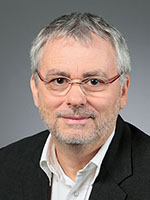 |
Luc THEVENAZ Ecole Polytechnique Fédérale de Lausanne (EPFL) Luc Thévenaz leads a research group at EPFL (Group for Fibre Optics) involved in photonics, namely fibre optics and optical sensing. Research topics include Brillouin-scattering fibre sensors, slow and fast light, nonlinear fibre optics and laser applications in gases. He also contributed to the development of distributed fibre sensing by proposing innovative concepts pushing beyond barriers. Prof. Thévenaz chaired the International Conference on Optical Fibre Sensors, is co-Executive Editor-in-Chief of Nature Light: Science & Applications and is an OSA and IEEE Fellow. Stimulated Brillouin Scattering in optical fibres: fundamentals and applications to sensing, slow & fast light and optical signal processing Keywords: Brillouin scattering, optical fibre, distributed fibre sensing, slow & fast light Summary: Coupling 2 lightwaves is only possible through the intercession of matter and acoustic vibrations turn out to offer the further advantage to make this coupling coherent. These material vibrations are stimulated by intensity-modulated lightwaves and their effect is detected through a phase-modulation on a distinct lightwave, so that the system is entirely activated and probed using light. We shall present the fundamentals of such a process designated as stimulated Brillouin scattering and it will be shown that an intense distributed amplification of light can be obtained. Since the acoustic properties are strongly dependent on the nature and the response of the hosting material, sensors based on such interactions can be made distributed and show remarkable and unique performance. Finally, such interactions can be efficiently exploited to actively modify the group velocity in a medium (slow & fast light), as well as to implement all-optical signal processing and coherent optical memories. References: 1. Advanced Fiber Optics: Concepts and Technology. Thévenaz, Luc, éd. Engineering Sciences. Lausanne, Switzerland: EPFL Press, distributed by CRC Press, 2011. 2. Motil, Avi, Arik Bergman, et Moshe Tur. State of the art of Brillouin fiber-optic distributed sensing. Optics & Laser Technology 78, Part A (2016): 81 103. 3. Thévenaz, Luc. Slow and fast light in optical fibres. Nat Photon 2, no 8 (2008): 474 81. 4. Santagiustina, Marco, Sanghoon Chin, Nicolay Primerov, Leonora Ursini, and Luc Thévenaz. All-optical signal processing using dynamic Brillouin gratings. Sci. Rep. 3 (3 avril 2013): 1594. |
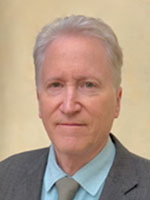 |
Kerry VAHALA California Institute of Technology Vahala studies devices called optical microcavities and their application to miniature frequency and time systems, microwave sources, parametric oscillators, astrocombs and gyroscopes. A member of the National Academy of Engineering and fellow of the IEEE and OSA, he received the IEEE Sarnoff Medal for research on quantum-well laser dynamics, the Alexander von Humboldt Award for work on ultra-high-Q optical microcavities, a NASA achievement award for application of microcombs to exoplanet detection, and the OSA Forman Team Engineering Excellence Award for a 2-photon optical clock. Brillouin Physics in High-Q Microresonators and Applications Keywords: Brillouin, Microresonator, Nonlinear optics, Microcavity Summary: Over the last decade an approach for generation of Brillouin lasers has emerged with implications for miniaturization and integration with other photonic devices as well as electronics. These devices generate Brillouin gain in compact high-Q optical cavities that are most often of the whispering-gallery-mode type wherein optical waves execute closed circular paths [1]. When the round trip optical loss in these resonators is very low (equivalently, the optical Q is very high), resonant enhancement of input couped power is large, making possible access to the stimulated Brillouin process at remarkably low pumping power levels less than 1 mW [2,3,4]. Such power levels are readily attainable with III-V semiconductor lasers. Also significant is that the high optical Q reduces the fundamental laser laser linewidth to below 1 Hz. The physics and microfabrication of these devices will be reviewed, followed by discussion of their application to Sagnac gyroscopes [5,6] as well as high-performance microwave signal sources [7,8]. References: [1] K. Vahala, Nature, (2003). [2] Lee, H. et al. Chemically etched ultrahigh-Q wedge-resonator on a silicon chip. Nat. Photon. 6, 369–373 (2012). [3] Tomes, M. & Carmon, T. Photonic micro-electromechanical systems vibrating at X-band (11-GHz) rates. Phys. Rev. Lett. 102, 113601 (2009). [4] Grudinin, I. S., Matsko, A. B. & Maleki, L. Brillouin lasing with a CaF2 whispering gallery mode resonator. Phys. Rev. Lett. 102, 043902 (2009). [5] Li, J., Suh, M.-G. & Vahala, K. Microresonator Brillouin gyroscope. Optica 4, 346–348 (2017). [6] Yu-Hung Lai, Myoung-Gyun Suh, Yu-Kun Lu, Boqiang Shen, Qi-Fan Yang, Heming Wang, Jiang Li, Seung Hoon Lee, Ki Youl Yang, Kerry Vahala, "Earth rotation measured by a chip-scale ring laser gyroscope", Nature Photonics 14, 345-349 (2020). [7] Li, J., Lee, H. & Vahala, K. J. Microwave synthesizer using an on-chip Brillouin oscillator. Nat. Commun. 4, 2097 (2013). [8] Li, J., Yi, X., Lee, H., Diddams, S. A. & Vahala, K. J. Electro-optical frequency division and stable microwave synthesis. Science 345, 309–313 (2014). |
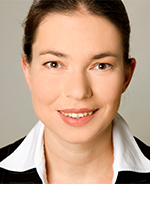 |
Eva WEIG Technical University of Munich Eva Weig studied Physics and obtained her Ph.D. at the Ludwig-Maximilians University in Munich. After two years as a postdoctoral researcher at the University of California in Santa Barbara in the groups of Andrew Cleland and John Martinis, she returned to LMU Munich to lead the Nanomechanics group at the Chair of Jorg Kotthaus. In 2013, she was appointed a Professor of Experimental Physics at the University of Konstanz, Germany. Since 2020, she leads the Chair of Nano & Quantum Sensors at the Technical University of Munich. Nanomechanical Systems Keywords: Nanomechanics, NEMS Summary: This lecture will focus on the resonant behavior of nanomechanical systems. These involve freely suspended nanostructures with discrete vibrational eigenmodes, such as, e.g., the flexural modes of a string or a membrane. Nanomechanical resonators are receiving an increasing amount of attention for a broad range of possible applications, ranging from practical sensing to fundamental challenges addressing the foundations of quantum mechanics. This lecture will give an overview over the field of nanomechanics, and highlight state of the art experiments. |